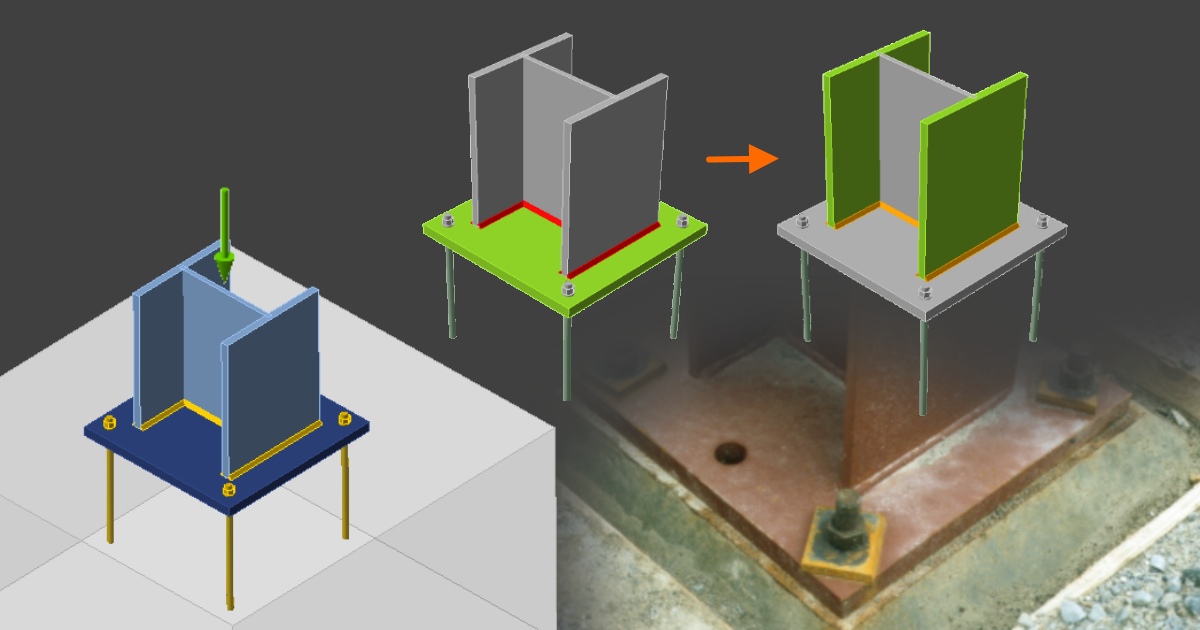Reduce weld costs by enhanced fabrication
It's interesting how different approaches to the same structure we could find throughout the regions, companies, or even between different designers. While some would weld everything together without thinking about a single bolt, others would cut the structure into several parts and connect everything together with dozens of bolts. Both approaches to connecting the structural members have their pros and cons.
Purely welded connections are stiffer than bolted connections and are thus considered to be safer or can reduce deflections. But then some experienced (meaning expensive) welder has to be somewhere on site, safely hanged in the space, often in inhospitable weather. The weld quality checks are sometimes not even possible, and the less precise work brings obviously higher material costs.
The workshop welding on the other hand may be more precise, it also requires transporting to the site. And onsite welding is often expensive in implementation and over-usage of welding materials. Read on to learn which approach best suits your projects.
You already know that IDEA StatiCa can help you calculate not only the stiffness of the weld connections but also estimate the costs of the connection depending on the weld type, etc. That is not something new under the sun. You can read one of our articles about the connection cost calculation.
But we also believe that connection designs should be as precise as possible while securing sufficient connection resistance. And one of our features can help you exactly with this.
Designing contact between column and base plate
Imagine you need to design a steel column welded to its base plate. The load must be transferred from the upper structure to the foundations. In certain countries, it is possible to include the contact between the column and its base plate when evaluating the compressive strength of the connection.
In most standards, such as Eurocode, the load is assumed to flow through the welds only. Therefore, the welds must be designed so that they resist the full compressive force from the structure above. Nevertheless, you can imagine that there exists a certain contact between the base of the column and its baseplate even before these two are welded together.
In some regions, the technical guides allow taking this contact into account when evaluating the compressive resistance. Of course, there are certain criteria to be fulfilled so that it is permitted to use this approach. Then, the contact brings an additional resistance to the compressive strength of the base weld which leads to a more economical design of the welds.
The model of the weld will then be set to have high stiffness. Once it starts to yield (i.e. to deform plastically), the contact is activated and the compression is taken by the contact. This leads to significant values of the stress in the weld even if the contact is applied. However, importantly, the resistance of the weld in shear is not decreased. The weld is not checked in compression anymore as this is taken by the contact but the tension and shear are still assigned to the weld and the appropriate checks are conducted.
Practically speaking, you will add a contact and a weld on the appropriate edges of the member (the column in this instance) at the same time. From the load transfer perspective, the contact will be effective in compression only while the welds will transfer shear and tension forces. Both operations are available under the “Weld or contact” manufacturing operation.
This is what you will see in IDEA StatiCa Connection:
- A red line representing the compressive contact is combined with a yellow line used to indicate the welds (when the transparent view is activated)
- In the results and reports, a down-facing arrow has been added next to the rectangle symbol of the fillet weld
You can apply any type of fillet weld in combination with the contact (i.e. continuous, partial, or intermittent). Butt welds are not combined by their very nature.
Procedure limitations
The presented approach can be applied when the actual manufacturing operations are guaranteed: the edges of the welded member must be precisely machined so that there is no gap between the welded items. Due to these strict criteria, this procedure is limited to certain countries such as The Netherlands and the United Kingdom. We cannot stress enough that the responsibility for this criteria to be fulfilled remains with the engineer.
Discover more
The combination of the contact in compression and a weld on the same edge of the steel plate is one of the new features in IDEA StatiCa version 22.1 released in October this year. See the full list of the new functionality in our Release notes of IDEA StatiCa 22.1 for steel and concrete or watch a live presentation in our What's new in IDEA StatiCa 22.1 release webinar.








